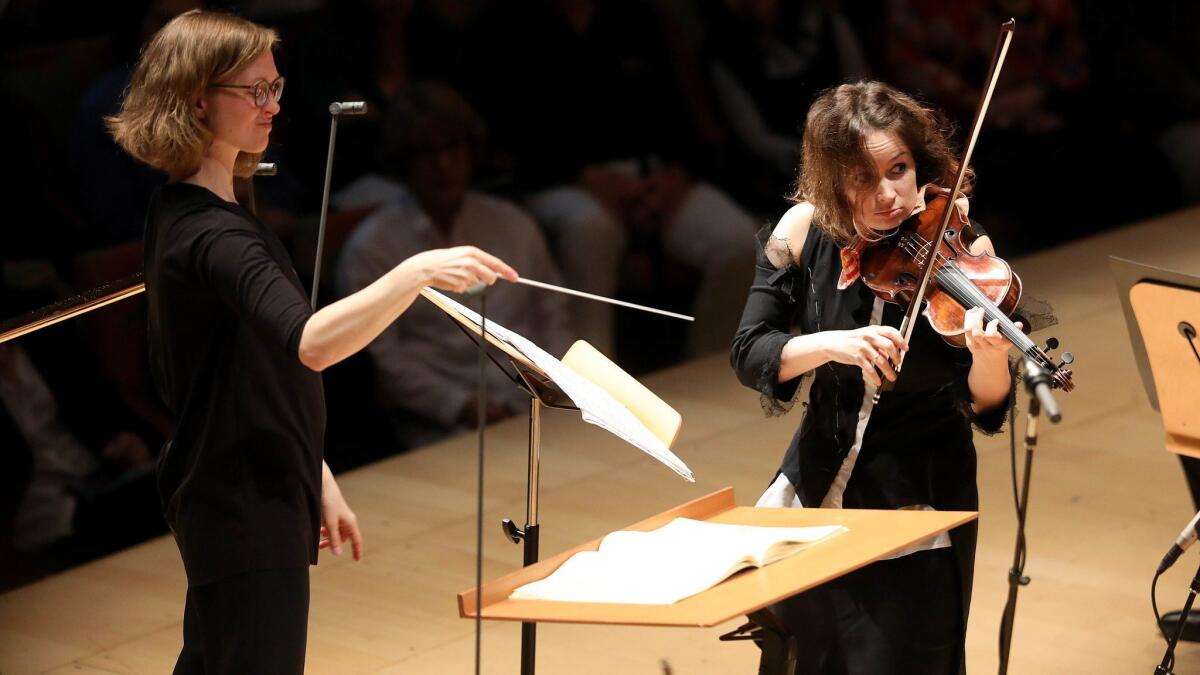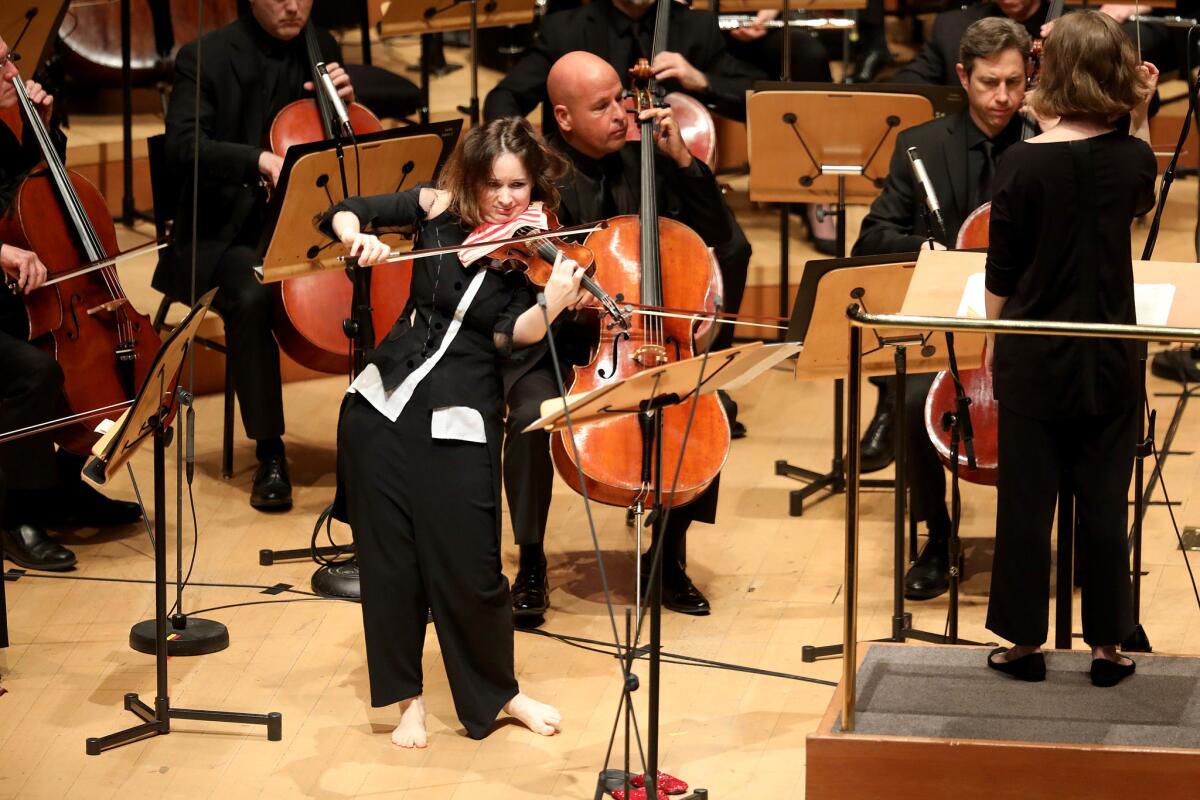Critic’s Notebook: Patricia Kopatchinskaja and Cameron Carpenter are resurrecting classical music

- Share via
Sunday afternoon at Walt Disney Concert Hall, violinist Patricia Kopatchinskaja radicalized Tchaikovsky’s Violin Concerto to the astonishment of some (by the end of the first movement, she got a standing ovation from a few in the audience, something I don’t remember witnessing before) and to stony-faced looks from the Los Angeles Philharmonic string section, also unusual. Social media reaction brought out mean-spiritedness.
That evening in an organ recital at Disney, Cameron Carpenter colorized and monumentalized Bach’s Toccata and Fugue in D minor, again to the astonishment of the audience. For a sour Bach purist, however, this could be viewed as the worst horror show for the score since the piece got turned into the soundtrack for the 1931 feature film “Dr. Jekyll and Mr. Hyde” or Walt Disney cartoon-ized it in “Fantasia.”
On this beautiful spring day, the sun shining and flowers blooming, Easter and Passover around the bend, I would like to suggest Sunday as nothing less than an occasion for musical resurrection, the bringing of played-to-death scores to new life.
Kopatchinskaja and Carpenter are the most transformative and convincingly individual musicians of their generation. She was born in the Moldavian Soviet Socialist Republic in 1977 and is Viennese trained. He’s a Pennsylvanian, born in 1981, and has a Juilliard pedigree. Their careers have not yet intersected. They make music very differently, and the Disney Hall crowds for afternoon and evening couldn’t have been more unalike.
But the spirit was exactly the same. Each is a phenomenal virtuoso with the necessary technique to burn and the bravery to then burn it. Although both have actively participated in the historically informed performance movement known as HIP, they are actually hip — true to the composers by being uncompromisingly true to the world and time we live in. They are not true to any school but their own.
Each is a phenomenal virtuoso with the necessary technique to burn and the bravery to then burn it.
Kopatchinskaja, who was the sensationally unconventional music director of the Ojai Music Festival last summer, was uncompromisingly true to Tchaikovsky, if in her own way. And, fortunately, she had a partner in Mirga Grazinyte-Tyla.
The music director of the City of Birmingham Symphony Orchestra and former L.A. Phil associate conductor has become a rising international star. Though greatly limiting her guest appearances to spend time with her newborn son, she has made a welcome exception for the L.A. Phil’s centennial season.
Grazinyte-Tyla’s sensitively elegant stability gave the violinist the antic expressive room she needed to hop around the stage figuratively and literally while still keeping the performance smartly yet excitingly together. I suppose the main reason Koptchinskaja can drive some musicians to distraction is her capacity to play every phrase differently than any other soloist ever has.
As with the flick of a switch, a barely audible lullaby is transformed into arresting dance music. She may toss off a bravura passage as though it were a fleeting thought or as though it were an urgent warning of danger.

She can appear childlike, discovering a well-worn melody in the concerto for the first time. She can just as readily appear an ageless oracle, repeating ancient wisdom. A single note might catch her attention and then she’ll turn to the orchestra, so they’ll want to explore that too. But this is not to be mistaken for deconstruction. Instead, Kopatchinskaja examined every musical gesture for possibilities and in so doing, Kopatchinskaja is not only hip but truly HIP.
Just last month one of the world’s leading experts on Russian music, Princeton musicologist Simon Morrison, inaugurated an online Times Literary Supplement series on music with an essay suggesting that Tchaikovsky’s surrealist aspects have gone unappreciated. Not by Kopatchinskaja, they haven’t. Her astounding encore was György Kurtág’s “Hommage à Tchaikovsky,” which comes from the Hungarian composer’s series of musical games for children and which she banged out in I’ll-show-you fashion on an upright piano.
She, in fact, goes one further and connects Tchaikovsky to surrealism’s successor art performance movement, Fluxus, which has been the subject of an L.A. Phil festival this season in conjunction with the Getty, where Kopatchinskaja played an entrancingly loopy yet still coherent program Saturday afternoon of John Cage, La Monte Young and Satie and others with pianist Gloria Cheng. Kopatchinskaja began by wandering onstage playing bits of the Tchaikovsky concerto.
In this context, her concerto performance then became easily the greatest Fluxus performance ever, making music mean something of the moment. Would Tchaikovsky be appalled, or would he have more likely been honored for having written music with a still-malleable meaning and not just a historic monument?
Nor did the L.A. Phil turn its back on gorgeousness. After intermission Grazinyte-Tyla led the premiere of Korean composer Unsuk Chin’s “Spira,” a concerto for orchestra that takes its sound world from a pair of bowed vibraphones spreading overtones all over the place, so they can be picked up by strings and winds and brass and bloom springlike into ever-expanding bouquet of glittery vibration.
Finally, in “La Mer,” Grazinyte-Tyla, who has begun using a baton, flooded Disney with sensual and dramatic Debussy. Seven years ago, when she first arrived in L.A. as a 26-year-old, she would bound onstage with exuberant youthful confidence. Though still young, she no longer bounds and now exudes the confidence of owning the room and the music, of brilliantly living up to all her early promise.
Carpenter also has had some work to do maturing and living up to his great promise. He’s toned down his attention-getting appearance considerably, trimming his hair and his jewelry. His recital was basically Bach, with none of his flashy arrangements or showpieces, with the exception of a romantically tinged improvisation and Toots Thielemans encore.
Even so, you can take the Swarovski off the boy but not the showmanship out of him. His Bach is Cameron-ed, and magnificently so. His feet tap dance on the organ pedals with a fleetness that puts Fred Astaire to shame. His fingers punch the stops on both sides of the keyboard with the monstrous facility of a worldwide video game champion. He is also a master of the swell, of getting low notes to fill the hall with tons of pressure and having high birdlike cheeps appearing at the edge of audibility.
On one level, this can be very confusing. You might think it would easy to follow a fugue (he included preludes and fugues BWV 532, 543 and 544) and the big, boisterous Passacaglia and Fugue in C) since every line has a different timbre. Instead there is anarchy, and when everything meshes, it sounds like newly invented harmonic wonder.
Like Kopatchinskaja, Carpenter is a musician who looks for possibilities, and for him the organ is one big color wheel with infinite options. His organ arrangement of Bach’s French Suite No. 5 becomes a riot of intriguing pastels, exquisitely evoking an earlier age for a modern listener in a way a harpsichord never quite could, however authentic.
What would Bach think? Why should we even care?
But this much you should be prepared for. There is something in the zeitgeist. Carpenter told the audience that it’s time he starts sharing the spotlight with a new generation of organists. He invited Thomas Mellan to play his manically unpredictable “Ballade de l’Impossible,” which had more than a little kinship with Kopatchinskaja’s Fluxus Cage and surreal Tchaikovsky.
SPRING PICKS: Mahler’s Eighth, Hannigan’s Ojai and ‘Central Park Five’ »
More to Read
The biggest entertainment stories
Get our big stories about Hollywood, film, television, music, arts, culture and more right in your inbox as soon as they publish.
You may occasionally receive promotional content from the Los Angeles Times.











